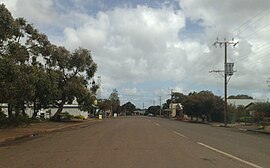Parndana, South Australia
|
Parndana South Australia |
|||||||||||||
|---|---|---|---|---|---|---|---|---|---|---|---|---|---|

Parndana
|
|||||||||||||
| Coordinates | 35°47′25″S 137°15′46″E / 35.79028°S 137.26278°ECoordinates: 35°47′25″S 137°15′46″E / 35.79028°S 137.26278°E | ||||||||||||
| Population | 142 (2011 census) | ||||||||||||
| Established | 1951 | ||||||||||||
| Postcode(s) | 5220 | ||||||||||||
| Time zone | ACST (UTC+9:30) | ||||||||||||
| • Summer (DST) | ACDT (UTC+10:30) | ||||||||||||
| Location | |||||||||||||
| LGA(s) | Kangaroo Island Council | ||||||||||||
| Region | Fleurieu and Kangaroo Island | ||||||||||||
| County | Carnarvon | ||||||||||||
| State electorate(s) | Finniss | ||||||||||||
| Federal Division(s) | Mayo | ||||||||||||
|
|||||||||||||
|
|||||||||||||
| Footnotes | Location Adjoining localities |
||||||||||||
Parndana is a small town on Kangaroo Island, South Australia, located 40 km west of Kingscote, the island's largest town.
Parndana was established after the Second World War to support the Soldier Settlement Scheme on Kangaroo Island. The name "Parndana" means "The Place of Little Gums".
Returned soldiers and their families began to arrive in the area in 1948, occupying huts brought from a former internment camp, and began to move onto their farms in 1951. A total of 174 families came to live in the area, almost doubling Kangaroo Island's population by 1954.
The Town of Parndana which was proclaimed on 26 July 1951 under the Crown Lands Act 1929-1944, occupied a triangular-shaped area of land in the cadastral unit of the Hundred of Seddon bounded by the Playford Highway on the north-west, the Rowland Hill Highway to the south-west and the Wedgewood Road to the east.
The soldier settlements were established on Crown land, which first had to be cleared of heavy native vegetation. Returned soldiers had to agree to live and work in camps to undertake this clearance work for a number of years before being allocated a block of land which then required further development before they could begin to farm the land, the costs of this further development being bourne by the settlers using government loans (arbitrarily administered by public servants without any specific knowledge of farming needs in the district). Many settlers were unable to succeed in raising sheep (recommended as the best use of the land) because of the widespread use of the Yarloop clover (recommended for use in heavy wet soils), which was subsequently discovered to reduce the fertility of sheep, but at the time the settlers were blamed for their poor farm management skills. Later it was an expensive exercise for farmers to remove the Yarloop clover and replace it with other varieties of clover. As a consequence of these issues, by the 1970s some settlers were in desperate financial circumstances and the government wanted to foreclose on their loans, forcing them to sell their farms, leading to desperate protests and legal action based on the misadvice they had received from public servants.
...
Wikipedia

